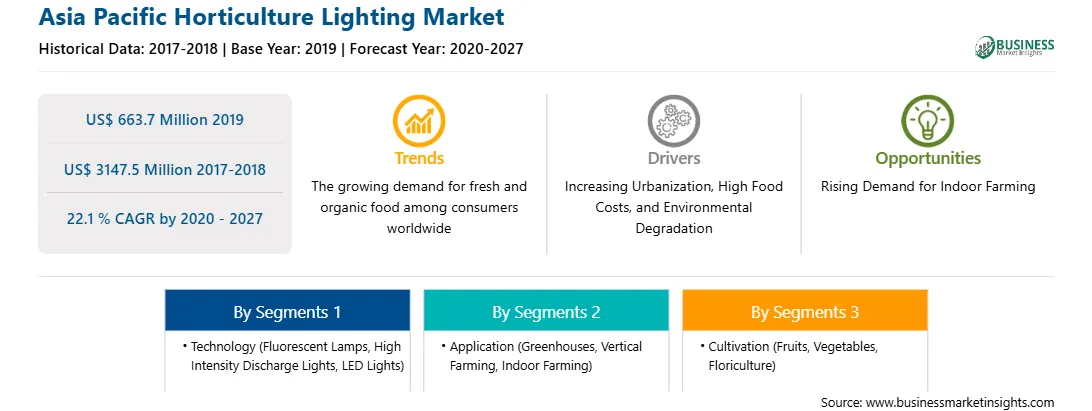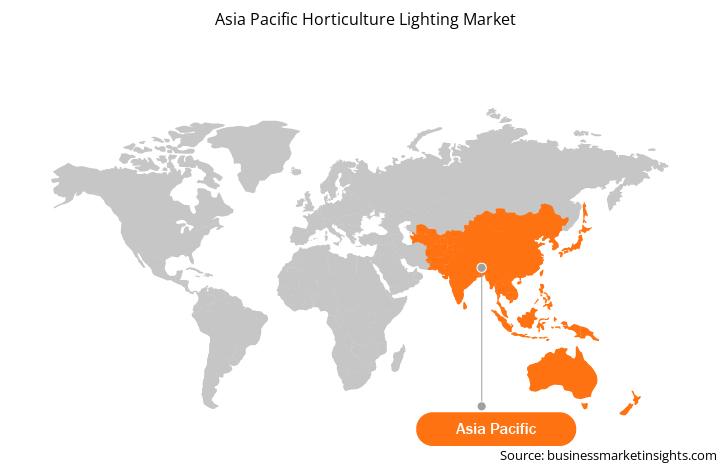Horticulture lighting is an artificial light used to facilitate photosynthesis. This process is beneficial in areas where adequate sunlight is absent. Horticulture lighting also enhances the growth of plants by illuminating them with artificial light. Horticulture's LED lighting technology is gaining traction in the APAC market due to its numerous advantages, such as low power consumption and existing technologies, which enable lower energy costs. Several countries in APAC region is expected to grow at the good rate during the forecast period. This can be attributed to increase in food requirement due to growing population. Horticultural lighting is used in urban agriculture, multi-layer cultivation, supplemental lighting, and daylight-free cultivation. Due to increasing awareness of sustainable farming, researchers, governments, and organizations have taken initiatives to improve horticulture with efficient and adequate lighting. Increase in demand for advanced lighting-related technologies is expected to boost the growth of the APAC horticulture lighting market. Companies have started to support the farmers by providing financial and technical support to establish vertical farms. Such developments in vertical agriculture are boosting the growth of the APAC horticulture lighting market. Factors such as growing government initiatives and surge in population and advancements in greenhouse and indoor farming techniques is expected to create a significant demand for horticulture lighting in the coming years, which is further anticipated to drive the APAC horticulture lighting market. Moreover, in case of COVID-19, APAC is highly affected specially China and India. APAC is characterized by a large number of developing countries, positive economic outlook, high industrial presence, huge population, and rising disposable income. All these factors make APAC a major growth driving region for various markets, including horticulture lighting. Due to the pandemic, uncertain consumer demand and supply chain problems have affected the horticulture lighting industry in the region. The lockdown of various factories in China affects the supply chains and negatively impacts the manufacturing and sales of various products and services. For the LED industry, since the supply chain mostly locates in this region and production majorly coming from China, the pandemic has an impact on the industry. The governments are taking drastic measures to reduce the effects of coronavirus outbreak by announcing lockdowns, travel, and trade bans. All these measures are expected to have a negative impact on the adoption and growth of horticulture lighting in 2020 and 2021.
Strategic insights for the Asia Pacific Horticulture Lighting provides data-driven analysis of the industry landscape, including current trends, key players, and regional nuances. These insights offer actionable recommendations, enabling readers to differentiate themselves from competitors by identifying untapped segments or developing unique value propositions. Leveraging data analytics, these insights help industry players anticipate the market shifts, whether investors, manufacturers, or other stakeholders. A future-oriented perspective is essential, helping stakeholders anticipate market shifts and position themselves for long-term success in this dynamic region. Ultimately, effective strategic insights empower readers to make informed decisions that drive profitability and achieve their business objectives within the market.

| Report Attribute | Details |
|---|---|
| Market size in 2019 | US$ 663.7 Million |
| Market Size by 2027 | US$ 3147.5 Million |
| Global CAGR (2020 - 2027) | 22.1 % |
| Historical Data | 2017-2018 |
| Forecast period | 2020-2027 |
| Segments Covered |
By Technology
|
| Regions and Countries Covered | Asia-Pacific
|
| Market leaders and key company profiles |
The geographic scope of the Asia Pacific Horticulture Lighting refers to the specific areas in which a business operates and competes. Understanding local distinctions, such as diverse consumer preferences (e.g., demand for specific plug types or battery backup durations), varying economic conditions, and regulatory environments, is crucial for tailoring strategies to specific markets. Businesses can expand their reach by identifying underserved areas or adapting their offerings to meet local demands. A clear market focus allows for more effective resource allocation, targeted marketing campaigns, and better positioning against local competitors, ultimately driving growth in those targeted areas.

The horticulture lighting market in APAC is expected to grow from US$ 663.7 million in 2019 to US$ 3147.5 million by 2027; it is estimated to grow at a CAGR of 22.1 % from 2020 to 2027.Growing significance of vertical farming is expected to surge the horticulture lighting market in APAC. Increase in population across APAC creates a huge demand for food, which cannot be fulfilled only through conventional or outdoor farming. In order to meet the increasing food demand, various countries are designing and implementing vertical farms, which includes cultivating plants on vertically inclined surfaces. Vertical farming produces crops by incorporating several technologies, such as robotics, big data analytics, and Artificial Intelligence (AI); thus, it produces healthy crops without any agronomic constraint. The environmental degradation caused by traditional farming methods allows various countries in APAC to opt for vertical farming. It ensures pollution degradation and leads to growing food production and mitigates resources. It produces crops by artificially stacking plants vertically above each other, which may reduce the issues of malnutrition and contaminated food in the coming years. Vertical farming offers numerous opportunities for growers to sustainably produce crops by diminishing the use of water, reducing fertilizers, maintaining healthy ecosystems, and safeguarding crops from weather-related disasters. Several advantages of vertical farming over conventional farming is expected to drive the APAC horticulture lighting market.
In terms of technology, the LED lights segment accounted for the largest share of the APAC horticulture lighting market in 2019. In terms of application, the greenhouses segment held a larger market share of the APAC horticulture lighting market in 2019. Further, the fruits & vegetables segment held a larger share of the market based on cultivation in 2019.
A few major primary and secondary sources referred to for preparing this report on the horticulture lighting market in APAC are company websites, annual reports, financial reports, national government documents, and statistical database, among others. Major companies listed in the report are General Electric Company; Heliospectra AB; Hubbell, Inc.; Lumileds Holding B.V.; OSRAM Licht AG; Signify N.V.
The List of Companies - Asia-Pacific Horticulture Lighting Market
The Asia Pacific Horticulture Lighting Market is valued at US$ 663.7 Million in 2019, it is projected to reach US$ 3147.5 Million by 2027.
As per our report Asia Pacific Horticulture Lighting Market, the market size is valued at US$ 663.7 Million in 2019, projecting it to reach US$ 3147.5 Million by 2027. This translates to a CAGR of approximately 22.1 % during the forecast period.
The Asia Pacific Horticulture Lighting Market report typically cover these key segments-
The historic period, base year, and forecast period can vary slightly depending on the specific market research report. However, for the Asia Pacific Horticulture Lighting Market report:
The Asia Pacific Horticulture Lighting Market is populated by several key players, each contributing to its growth and innovation. Some of the major players include:
The Asia Pacific Horticulture Lighting Market report is valuable for diverse stakeholders, including:
Essentially, anyone involved in or considering involvement in the Asia Pacific Horticulture Lighting Market value chain can benefit from the information contained in a comprehensive market report.